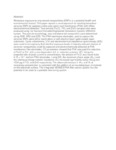Capture, isolation and electrochemical detection of industrially-relevant engineered aerosol nanoparticles using poly (amic) acid, phase-inverted, nano-membranes

View/
Date
2014-08-30Author
Okello, Veronica A.
Gass, Samuel
Pyrgiotakis, Georgios
Metadata
Show full item recordAbstract
Workplace exposure to engineered nanoparticles (ENPs) is a potential health and
environmental hazard. This paper reports a novel approach for tracking hazardous
airborne ENPs by applying online poly (amic) acid membranes (PAA) with offline
electrochemical detection. Test aerosol (Fe2O3, TiO2 and ZnO) nanoparticles were
produced using the Harvard (Versatile Engineered Generation System) VENGES
system. The particle morphology, size and elemental composition were determined
using SEM, XRD and EDS. The PAA membrane electrodes used to capture the
airborne ENPs were either stand-alone or with electron-beam gold-coated paper
substrates. Cyclic voltammetry (CV) and electrochemical impedance spectroscopy (EIS)
were used to conceptually illustrate that exposure levels of industry-relevant classes of
airborne nanoparticles could be captured and electrochemically detected at PAA
membranes filter electrodes. CV parameters showed that PAA catalyzed the reduction
of Fe2O3 to Fe2+ with a size-dependent shift in reduction potential (E0). Using the
proportionality of peak current to concentration, the amount of Fe2O3 was found to be
4.15 × 10−17 mol/cm3 PAA electrodes. Using EIS, the maximum phase angle (Φmax) and
the interfacial charge transfer resistance (Rct) increased significantly using 100 μg and
1000 μg of TiO2 and ZnO respectively. The observed increase in Φmax and Rct at
increasing concentration is consistent with the addition of an insulating layer of material
on the electrode surface. The integrated VENGES/PAA filter sensor system has the
potential to be used as a portable monitoring system.
URI
https://www.sciencedirect.com/science/article/pii/S0304389414005743http://ir.mksu.ac.ke/handle/123456780/1554
